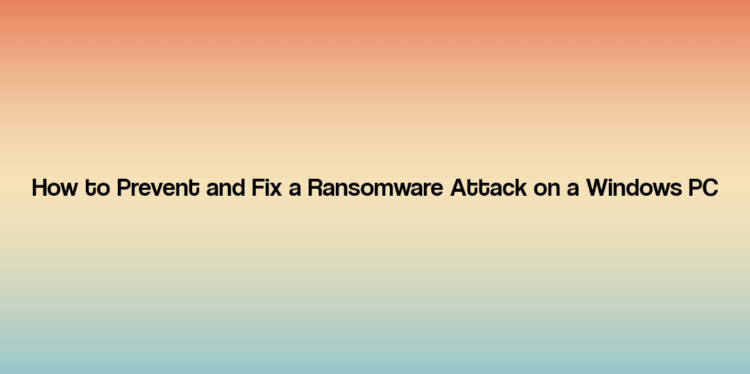Page Contents
How to Prevent and Fix a Ransomware Attack on a Windows PC
Ransomware is a major online issue, costing people and businesses billions of dollars every year. It can be destructive for your computer, but you can take some simple steps to prevent it.
Businesses can pay staggering sums to recover their data following a ransomware attack – an average of $1.85 million per incident. Attacks target people as well as businesses, either to find a way into your work-from-home computer or to get money from you directly.

It’s a scary prospect to become the victim of ransomware, so we’re going to breakdown:
- Exactly what a ransomware attack looks like;
- What to do if you become the target of ransomware;
- How you can prevent a ransomware attack from happening.
So you can keep your online life safe and secure.
What is ransomware?
Ransomware is a type of malware that encrypts your computer data that can be fixed by paying a ransom. It will generally infect your computer by:
- A link you click in a phishing email;
- Downloading a file from a dodgy website;
- Clicking on a malicious link in a social media message.
Once your computer is infected, you’ll receive an email or a warning on your screen telling you to pay money or lose access to your data and files forever. It’s also very possible that you’ll get this message but your computer isn’t infected – preying on your potential lack of knowledge.
Usually, you’ll be direct to make a payment through Bitcoin or other cryptocurrencies. Cybercriminals choose this method because they can’t be traced once you’ve sent the coins.
How does ransomware affect my computer?
In a genuine ransomware attack, your hard drive or specific files will get encrypted. This means they’ll be turned into code that you need a key to undo – which you’ll get once you pay up.
It may also target specific files, maybe your schoolwork or files of photos and videos that are valuable to you. Whatever part of your computer it targets, you won’t be able to access it while it’s under attack.
Fake ransomware attacks are also a thing. This is where the attacker will tell you they have your files, your personal information, or potentially embarrassing data in your browsing history. They tell you they’ll share your data with your email or phone contacts unless you pay up.
What do I do if I get a ransomware message?
If you get a ransomware email or pop-up on your computer, first; please don’t panic. You need to isolate your device, so put it into Airplane Mode, this will stop any other devices on your network from getting infected.
Next, use a different device to search for information about the type of ransomware you’ve been targeted with. A site like NoMoreRansom may have a key to unlock what you’ve been attacked with. You can also search for a technician in your area to help.
You should never pay a ransom, as scary as it might be that your computer is locked. It’s rare that you’ll get all your data back and you also encourage and fund more illegal activity.
If you have a backup of your computer data, you can also try restoring that. This should set your computer back to where it was before the ransomware got installed.
How can I prevent a ransomware attack?
You can take some simple and effective actions to help prevent ransomware. Not only will you be assured that a fake attack is just that, but you can be confident you won’t get hit with an actual piece of malicious software.
Use a VPN at all times
A VPN masks the actual location you’re connected from, which is especially important when you’re using a public network but also useful at home in case someone hacks your Wi-Fi.
It sounds very technical but is pretty simple to get set up – you can get a free VPN trial here and see how well it works for your needs.
Use an anti-virus software
When you use Windows 10 or 11 on your PC, you’ll have Windows Defender as standard. This is one of the best anti-virus and anti-malware software available, and it’s completely free.
Check your Windows Defender settings so that it stays up-to-date and is regularly scanning your computer.
Install updates regularly
That little orange dot in your power button gets annoying, right? It might take a little longer to power down your computer but you should always download and install Windows updates as soon as possible.
Keep all your other apps updated as well, such as your chat apps, games, and other tools you have installed. Your computer won’t be vulnerable to attack if you make sure patches are downloaded.
Be skeptical
You need to keep your wits about you when you’re online. Check the source of an email and make sure the address is genuinely from the company it claims to be. A real email from a legit company will never ask you to click on a link to reset your security, for example.
Check the URLs of the sites you browse, as well. Cybercriminals can spoof websites with a slight change to the URL and get you to download a piece of ransomware. Always be on the lookout for small things that look or feel different from normal.
Conclusion
Ransomware can be devastating for a business or a person – it’s scary to lose all your work, pictures, and other files. You can prevent ransomware with some simple steps that should prevent most attacks from reaching your screen or hard drive.